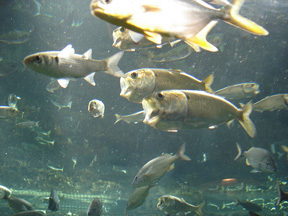Chesapeake Bay's Independent Newspaper ~ Since 1993
1629 Forest Drive, Annapolis, MD 21403 ~ 410-626-9888
Volume xviii, Issue 20 ~ May 20 to May 26, 2010
Home \\ Correspondence \\ from the Editor \\ Submit a Letter \\ Classifieds \\ Contact Us
Best of the Bay \\ Dining Guide \\ Home & Garden Guide \\ Archives \\ Distribution \\ Advertising![]()


The Bay's Other Great Filter
Scooping up suspended plant matter and algae, a typical menhaden filters seven gallons of water a minute, dwarfing even the oyster
Also called pogy, mossbunker, fatback, bugmouth and about 25 other names, they are all the same creature, menhaden, and the most important fish that swims in our Chesapeake. The fish with many names is also an essential resident along the Atlantic seaboard because it is a main ecological building block for our entire marine food web.
A schooling, silvery fish about 15 inches long with an enormous mouth and weighing a pound or so, it is bony, smelly and poor tasting. But everything and everyone loves the menhaden.
Bay watermen like the fish because it makes the best bait for their crab pots. Chesapeake anglers love it because it is a favorite lure for rockfish, bluefish and seatrout. Women all over love menhaden (though they probably don’t know it) because its oil is one of the best and safest emollients used in the production of cosmetics.
Health-conscious people everywhere love the fish because it is a significant source of Omega 3 oils, a proven, heart-healthy food supplement.
Manufacturers all over love the menhaden because its proteins and oils are cheap additives to livestock and pet foods, agricultural fertilizer, tire manufacture, lubricants, soap and countless other products found around the world.
Loving Them To Death
But all this love is wiping out a fish that holds an even more critical place in nature than we realized as we first began to harvest them over 300 years ago. When colonists arrived in the Chesapeake, they could clearly see the bottom in 30 feet of water. That was when menhaden were the most numerous fish in our Bay — and the Atlantic.
As filter feeders, menhaden swim in large, densely packed schools with open mouths, scooping up suspended plant matter and algae. An active fish will filter seven gallons of water each minute, dwarfing even the oyster as the main marine ecological cleansing system, especially in waters such as our Bay.
Over time, because of the increasing manufacturing demand for menhaden, the stocks of these fish have been depleted state by state along the whole Atlantic seaboard. Finally in 2010, with the population at an historic low, only Virginia continues to allow a commercial menhaden operation. But that fishery operates with a vengeance at the mouth of the Chesapeake.
Harvesting 90 percent of the total menhaden taken nationally, Omega Protein, a Texas-based corporation, uses spotter planes, large ships and enormous nets to capture entire schools of these fish trying to enter the Chesapeake Bay. They take over 350 million pounds of menhaden every year, fish that are vital to the health of our waters.
Massive dead zones have been occurring with increasing regularity in the Chesapeake. These are large areas of oxygen-depleted water created by decomposed plant material and algae no longer filtered out of the waters. The zones are devastating marine life throughout the Bay.
Rockfish in the Chesapeake have also begun to suffer because of the scarcity of menhaden as other less nutritious species become a greater part of their diet. It is widely argued that lack of menhaden is the culprit behind the rockfish’s increased susceptibility to bacterial infection. Skinny stripers with ugly red sores along their flanks are being encountered by Bay anglers in ever-increasing frequency.
Efforts to curtail the commercial menhaden fishery have been in vain. The Virginia legislature, years ago, wrested control of menhaden from traditional state fishery oversight and permits Omega Protein virtually free rein to harvest these fish. Omega in return donates generously to Virginia’s political coffers. Omega also, reportedly, dumps a million gallons of fish waste every month of the season into the Chesapeake.
The Atlantic States Marine Fisheries Commission, which exercises federal authority over the harvest of menhaden, has finally noticed that menhaden are in danger of collapse due to overfishing in at least 32 of the last 55 years. Now the Commission has decided to do something about the situation. What that something is has yet to be determined.
Fish Are Biting
The rockfish trophy season is over, and the size limit for rockfish is now 18 inches with a two-fish limit, only one of which can be over 28 inches. Fishing is still limited to the main stem of the Chesapeake until June 1, when the tributaries will open as well. Chumming is becoming productive, with some nice stripers being taken at Hackett’s and Podickery. It’s a good idea to use circle hooks with this type of fishery to avoid unnecessary rockfish mortality.
White perch are still hard to find, but croaker are becoming more numerous. A few seatrout have been taken on the Honga and at Hoopers, where the croaker bite is reported as quite good, though Point Lookout is the site of the best harvest.
Crabs are slow to appear this year with all the chilly weather, but they should begin to move about as June blooms.
In Season
Spring turkey for gobblers remains open through May 24.
© COPYRIGHT 2010 by New Bay Enterprises, Inc. All rights reserved.

